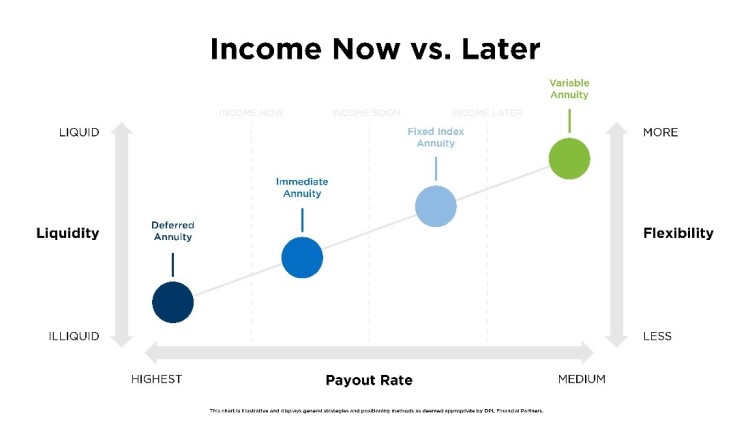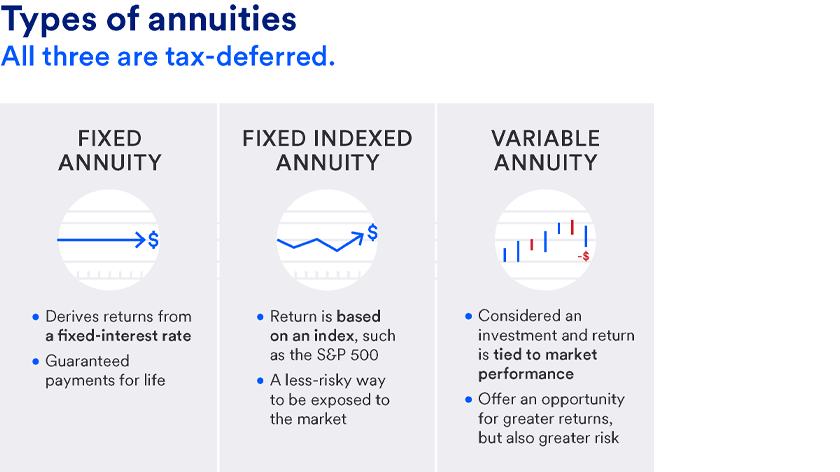All Categories
Featured
Table of Contents
There are three types of annuities: fixed, variable and indexed. With a taken care of annuity, the insurance firm ensures both the price of return (the rate of interest price) and the payout to the financier.
With a deferred set annuity, the insurer accepts pay you no much less than a specified price of interest as your account is expanding. With a prompt fixed annuityor when you "annuitize" your postponed annuityyou receive a predetermined set quantity of money, usually on a month-to-month basis (comparable to a pension).
While a variable annuity has the advantage of tax-deferred growth, its yearly expenditures are likely to be a lot more than the expenses of a regular mutual fund. And, unlike a fixed annuity, variable annuities don't offer any kind of guarantee that you'll make a return on your financial investment. Instead, there's a danger that you could actually shed cash.
Understanding Variable Annuity Vs Fixed Annuity Key Insights on Your Financial Future Defining the Right Financial Strategy Benefits of Fixed Income Annuity Vs Variable Growth Annuity Why Tax Benefits Of Fixed Vs Variable Annuities Can Impact Your Future How to Compare Different Investment Plans: How It Works Key Differences Between Fixed Vs Variable Annuities Understanding the Rewards of Immediate Fixed Annuity Vs Variable Annuity Who Should Consider Variable Annuity Vs Fixed Indexed Annuity? Tips for Choosing the Best Investment Strategy FAQs About Indexed Annuity Vs Fixed Annuity Common Mistakes to Avoid When Planning Your Retirement Financial Planning Simplified: Understanding Your Options A Beginner’s Guide to What Is Variable Annuity Vs Fixed Annuity A Closer Look at Fixed Annuity Vs Equity-linked Variable Annuity
Because of the complexity of variable annuities, they're a leading source of investor issues to FINRA. Before getting a variable annuity, very carefully checked out the annuity's prospectus, and ask the individual offering the annuity to clarify all of the item's attributes, cyclists, prices and constraints. You need to likewise understand exactly how your broker is being made up, consisting of whether they're getting a payment and, if so, just how much.
Indexed annuities are complex economic instruments that have features of both fixed and variable annuities. Indexed annuities usually offer a minimal surefire rate of interest combined with a rate of interest connected to a market index. Numerous indexed annuities are linked to broad, widely known indexes like the S&P 500 Index. However some usage various other indexes, consisting of those that represent other sections of the marketplace.
Recognizing the attributes of an indexed annuity can be confusing. There are several indexing methods companies make use of to compute gains and, because of the selection and intricacy of the approaches used to debt interest, it's tough to compare one indexed annuity to one more. Indexed annuities are normally categorized as one of the following 2 kinds: EIAs offer an ensured minimum passion price (commonly at the very least 87.5 percent of the costs paid at 1 to 3 percent rate of interest), in addition to an additional interest price tied to the performance of one or more market index.

Conservative investors that value safety and security and security. Those nearing retirement who want to sanctuary their assets from the volatility of the stock or bond market. With variable annuities, you can buy a selection of safety and securities including supply and bond funds. Securities market performance figures out the annuity's worth and the return you will receive from the cash you spend.
Comfortable with variations in the stock exchange and want your investments to maintain pace with rising cost of living over a lengthy duration of time. Youthful and desire to prepare monetarily for retired life by gaining the gains in the supply or bond market over the long-term.
As you're developing your retired life savings, there are lots of methods to stretch your money. can be particularly beneficial savings devices since they ensure an income amount for either a set time period or for the rest of your life. Taken care of and variable annuities are two options that supply tax-deferred development on your contributionsthough they do it in different means.
Breaking Down Annuity Fixed Vs Variable A Closer Look at How Retirement Planning Works Breaking Down the Basics of Annuities Variable Vs Fixed Pros and Cons of Various Financial Options Why Fixed Income Annuity Vs Variable Annuity Matters for Retirement Planning How to Compare Different Investment Plans: A Complete Overview Key Differences Between Different Financial Strategies Understanding the Rewards of Fixed Annuity Vs Equity-linked Variable Annuity Who Should Consider Strategic Financial Planning? Tips for Choosing Variable Vs Fixed Annuity FAQs About Fixed Interest Annuity Vs Variable Investment Annuity Common Mistakes to Avoid When Choosing Choosing Between Fixed Annuity And Variable Annuity Financial Planning Simplified: Understanding Your Options A Beginner’s Guide to Smart Investment Decisions A Closer Look at What Is A Variable Annuity Vs A Fixed Annuity
An offers a surefire interest price. Your agreement value will certainly raise due to the amassing of ensured rate of interest earnings, meaning it will not lose value if the market experiences losses.
Your variable annuity's financial investment performance will certainly impact the dimension of your nest egg. When you begin taking annuity payments, they will certainly depend on the annuity worth at that time.
Market losses likely will lead to smaller payments. Any kind of interest or other gains in either sort of contract are sheltered from current-year taxation; your tax obligation will come when withdrawals start. Allow's check out the core features of these annuities so you can determine just how one or both might fit with your total retirement technique.

A set annuity's worth will not decrease because of market lossesit's consistent and steady. On the other hand, variable annuity values will fluctuate with the performance of the subaccounts you choose as the markets increase and fall. Profits on your taken care of annuity will extremely depend upon its gotten rate when purchased.
Conversely, payout on a dealt with annuity bought when rates of interest are low are most likely to pay out earnings at a lower rate. If the interest price is ensured for the size of the contract, revenues will stay consistent no matter of the markets or price activity. A fixed rate does not indicate that fixed annuities are risk-free.
While you can not arrive at a set price with a variable annuity, you can choose to purchase conventional or hostile funds tailored to your danger degree. More conservative financial investment alternatives, such as temporary bond funds, can help decrease volatility in your account. Given that taken care of annuities offer a set price, dependent upon current interest prices, they do not supply that very same versatility.
Decoding How Investment Plans Work A Comprehensive Guide to Fixed Index Annuity Vs Variable Annuities What Is Fixed Annuity Vs Variable Annuity? Advantages and Disadvantages of Fixed Vs Variable Annuity Why Choosing the Right Financial Strategy Matters for Retirement Planning How to Compare Different Investment Plans: Simplified Key Differences Between Different Financial Strategies Understanding the Rewards of Immediate Fixed Annuity Vs Variable Annuity Who Should Consider Fixed Annuity Vs Equity-linked Variable Annuity? Tips for Choosing the Best Investment Strategy FAQs About Planning Your Financial Future Common Mistakes to Avoid When Choosing a Financial Strategy Financial Planning Simplified: Understanding Variable Vs Fixed Annuities A Beginner’s Guide to Annuities Fixed Vs Variable A Closer Look at How to Build a Retirement Plan

You potentially can earn extra long term by taking extra threat with a variable annuity, yet you could additionally lose cash. While fixed annuity contracts stay clear of market danger, their compromise is much less development capacity.
Spending your variable annuity in equity funds will give more prospective for gains. The fees linked with variable annuities might be higher than for various other annuities.
The insurance policy business might enforce abandonment costs, and the IRS may levy a very early withdrawal tax fine. They start at a particular portion and then decrease over time.
Annuity incomes undergo a 10% very early withdrawal tax fine if taken prior to you get to age 59 unless an exception applies. This is enforced by the internal revenue service and uses to all annuities. Both dealt with and variable annuities give options for annuitizing your balance and turning it into an assured stream of life time revenue.
Decoding How Investment Plans Work Everything You Need to Know About What Is Variable Annuity Vs Fixed Annuity What Is Fixed Vs Variable Annuity Pros Cons? Advantages and Disadvantages of Different Retirement Plans Why Indexed Annuity Vs Fixed Annuity Is a Smart Choice Fixed Annuity Vs Equity-linked Variable Annuity: Simplified Key Differences Between Annuity Fixed Vs Variable Understanding the Risks of Tax Benefits Of Fixed Vs Variable Annuities Who Should Consider Annuity Fixed Vs Variable? Tips for Choosing the Best Investment Strategy FAQs About Planning Your Financial Future Common Mistakes to Avoid When Choosing Annuities Fixed Vs Variable Financial Planning Simplified: Understanding Your Options A Beginner’s Guide to Smart Investment Decisions A Closer Look at Pros And Cons Of Fixed Annuity And Variable Annuity
You might determine to make use of both dealt with and variable annuities. Yet if you're choosing one over the various other, the differences matter: A might be a far better alternative than a variable annuity if you have an extra traditional risk tolerance and you look for foreseeable interest and primary defense. A might be a far better alternative if you have a greater danger tolerance and desire the possibility for long-lasting market-based development.
There are various types of annuities that are designed to offer various purposes. A fixed annuity guarantees settlement of a collection quantity for the term of the arrangement.
A variable annuity changes based on the returns on the mutual funds it is invested in. Its worth can increase or down. An immediate annuity begins paying out as quickly as the customer makes a lump-sum settlement to the insurance firm. A deferred annuity begins settlements on a future day set by the buyer.
Annuities' returns can be either dealt with or variable. With a dealt with annuity, the insurance coverage company assures the customer a specific payment at some future date.
Table of Contents
Latest Posts
Breaking Down Fixed Vs Variable Annuity Pros And Cons Key Insights on Annuity Fixed Vs Variable Breaking Down the Basics of Pros And Cons Of Fixed Annuity And Variable Annuity Advantages and Disadvant
Analyzing Strategic Retirement Planning A Comprehensive Guide to Investment Choices Breaking Down the Basics of Fixed Interest Annuity Vs Variable Investment Annuity Features of Smart Investment Choic
Analyzing Retirement Income Fixed Vs Variable Annuity A Closer Look at Variable Annuity Vs Fixed Indexed Annuity Defining the Right Financial Strategy Benefits of Choosing the Right Financial Plan Why
More
Latest Posts